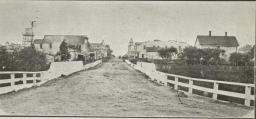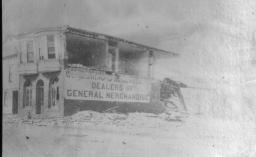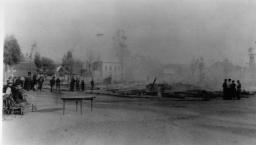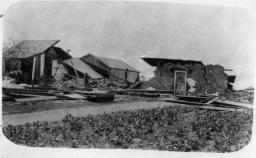 Sybil Easterday’s rooster should have awakened her from her deep sleep on the morning of April 18, 1906. Instead the well known eccentric sculptress, who lived with her mother, Flora, in an artistic home at Tunitas Creek, south of Half Moon Bay, found herself captive to the sudden shaking and moving of the earth.
Sybil Easterday’s rooster should have awakened her from her deep sleep on the morning of April 18, 1906. Instead the well known eccentric sculptress, who lived with her mother, Flora, in an artistic home at Tunitas Creek, south of Half Moon Bay, found herself captive to the sudden shaking and moving of the earth.
There was no fighting back with this earthquake; it was very powerful and held their very lives in the balance.
Flora Easterday, a pianist, desperately clutched a table to keep from falling. It looked as if she were on a violent jumping jack–like some giant monster was tearing away the floors and walls
When the shuddering stopped, the Easterdays rushed outside to make sure the world they had known was still there. What they found were huge cracks in the earth– cracks big enough to engulf a human leg, and they threw fistfuls of loose dirt into the fissures so that the baby ducks wouldn’t get swallowed up.
The Easterday’s Tunitas Creek home was a stone’s throw from the Ocean Shore Railroad’s future depot-—but until the day before the quake workers were laying tracks 15 or so miles to the north near Mussel Rock—where the San Andreas Fault rises from the sea and heads inland.
Actual grading for the railroad had reached several miles further south and as the ground trembled the land exposed hundreds of deep crevices. Boulders tumbled down near Devil’s Slide and the big rocks swept away the Ocean Shore’s expensive equipment as they rolled over the fragile cliffs into the Pacific Ocean. Seconds after the powerful vibrations ceased, the railroad bed was contorted beyond recognition.
The Ocean Shore Railroad had already experienced financial difficulties but it was the 1906 earthquake that struck the killer blow.

In Half Moon Bay the quake’s damage was swift and brutal, snuffing out life and wrecking businesses and homes on or near Main Street. The general store, Cereghino & Debenedetti, lost an entire wall, giving the impression that a tornado had blown through the building. That would be easier to repair than what happened to Levy Brothers, a much larger store– a brick structure that simply collapsed leaving behind nothing but dust.

Perhaps the greatest historical loss was the Vasquez Adobe, which dated back to the mid-1800s. In that tragedy a dozen people were buried alive.

Giant boulders also blocked the Half Moon Bay-San Mateo Road, today known as Highway 92. But intrepid stagecoach driver McFadden refused to allow the rocks to stand in his way.
His stagecoach arrived in Half Moon Bay with a screech and soon was surrounded by a crowd of locals, desperate to know how bad things were elsewhere. When McFadden breathlessly told them that most of San Francisco lay in ruins, his report was met with a stunned silence.
Photo (1) Half Moon Bay, before the earthquake
Photo (2) Cereghino & Debenedetti General Store, courtesy Henry Debenedetti
Photo (3) Levy Brothers, courtesy San Mateo County History Museum
Photo (4) Vasquez Adobe, courtesy Spanishtown Historical Society
